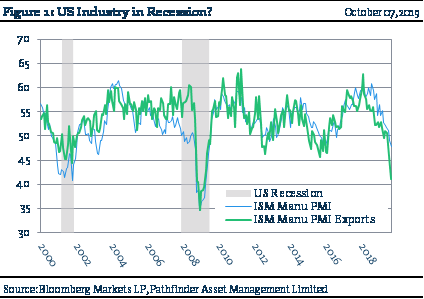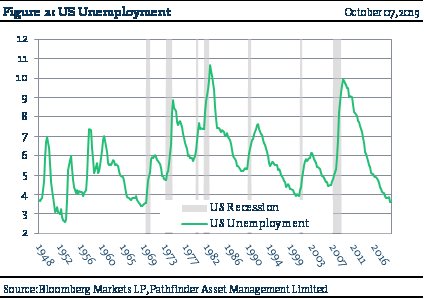Recap & Outlook: Macro Machinations
Last month markets generally rallied and pushed to new highs. We also noticed price volatility decreased. At the beginning of this week, headlines in the financial and political press turned negative. Markets subsequently “gave up” the August through October gains with two very negative days. At the end of the week investors/traders/speculators seemed to have calmed down somewhat and markets rallied back a bit:
- Figure 1 presents an ugly print from the Institute of Supply and Management report. This report provides an outlook on general business activity. The blue line indicates that general business is slowing while the the green indicates that exports have not been this bad since 2009. We believe this comes from sentiment related to the US and China trade war.
- Figure 2 presents employment data. As you can see, the unemployment rate reached a 50-year low. With low unemployment, low inflation and increasing wage growth, the US consumer is still healthy.
- We read a number of industry reports from investment banks and research houses. It seems from the tone of those reports that the investment community is expecting the US Federal Open Market Committee (FOMC) to decrease its administered rate at the end of the month. We are also able to confirm this view with fed futures data that we regularly track. The FOMC would do this to shore up business and investor confidence in order to extend the economic cycle, which is already the longest in history.


This means that” The first chart shows that there is concern with US businesses and industry (i.e. we should be concerned about this). It caused an ugly market reaction at the beginning of the week. The second chart shows that employments and subsequently the consumer is still strong (i.e. the consumer is two thirds of GDP, so this is good news). This is the crux of the debate that is going on in financial markets right now. We have previously mentioned this in past Investment Outlooks. We hold cash in a number of our mandates both as a risk mitigator and for the opportunity to add good quality businesses at a fair price. Recent volatility has allowed us to both buy and sell these businesses.
National Instrument 31-103 requires registered firms to disclose information that a reasonable investor would expect to know, including any material conflicts with the firm or its representatives. Doug Johnson and/or Pathfinder Asset Management Limited are an insider of companies periodically mentioned in this report. Please visit www.paml.ca for full disclosures.
*All returns are time weighted and net of investment management fees. Returns from the Pathfinder Partners’ Fund and Partners’ Real Return Plus Fund are presented based on the masters series of each fund. The Pathfinder Core: Equity Portfolio and The Pathfinder Core: High Income Portfolio are live accounts. These are actual accounts owned by the Pathfinder Chairman (Equity) and client (High Income) which contain no legacy positions, cash flows or other Pathfinder investment mandates or products. Monthly inception dates for each fund and portfolio are as follows: Pathfinder Core: Equity Portfolio (January 2011), Pathfinder Core: High Income Portfolio (October 2012) Partners’ Fund (April 2011), Partners’ Real Return Plus Fund (April, 2013), and Partners’ Core Plus Fund (November 2014).
Pathfinder Asset Management Limited (PAML) and its affiliates may collectively beneficially own in excess of 10% of one or more classes of the issued and outstanding equity securities mentioned in this newsletter. This publication is intended only to convey information. It is not to be construed as an investment guide or as an offer or solicitation of an offer to buy or sell any of the securities mentioned in it. The author has taken all usual and reasonable precautions to determine that the information contained in this publication has been obtained from sources believed to be reliable and that the procedures used to summarize and analyze such information are based on approved practices and principles in the investment industry. However, the market forces underlying investment value are subject to sudden and dramatic changes and data availability varies from one moment to the next. Consequently, neither the author nor PAML can make any warranty as to the accuracy or completeness of information, analysis or views contained in this publication or their usefulness or suitability in any particular circumstance. You should not undertake any investment or portfolio assessment or other transaction on the basis of this publication, but should first consult your portfolio manager, who can assess all relevant particulars of any proposed investment or transaction. PAML and the author accept no liability of any kind whatsoever or any damages or losses incurred by you as a result of reliance upon or use of this publication.